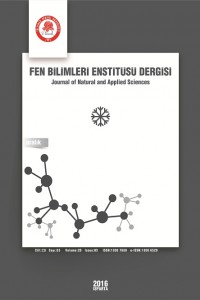Investigation of Using Waste Welded Tuff Material as Mineral Filler in Asphalt Concrete
Öz
In this paper, the welded tuff waste- known as koyke in Isparta region - was used in the hot mix asphalt (HMA) as mineral filler for reduction of the moisture susceptibility of HMA. Optimum binder content was assessed with Marshall Design Method. First of all, welded tuff was substituted as filler with limestone filler in proportion of 50% and 100%. After that Marshall Stability test was performed on specimens. The results showed that the 50% substitution was more effective than the 100% substitution. Therefore, welded tuff was substituted with limestone filler in proportion of 25%, 50%, 65% and 75%. Next, Indirect Tensile Strength test was practiced on the fabricated specimens and the results were assessed. According to the Indirect Tensile Strength results, welded tuff with 65% was given higher strength than the limestone filler. As a result, it has come up that welded tuff can be used as mineral filler in the hot mix asphalt.
Anahtar Kelimeler
Moisture susceptibility Welded tuff; Koyke; Tensile strength ratio
Kaynakça
- [1] Bahia, H., Hanz, A., Kanitpong, K., Wen, H. 2007. Test Method to Determine Aggregate/Asphalt Adhesion Properties and Potential Moisture Damage, Technical Report, Wisconsin Department of Transportation
- [2] AASHTO T 283. 1999. Resistance of compacted bituminous mixture to moisture induced damage Standard Specifications for Transportation Materials, AASHTO Washington, D.C.,
- [3] Fu H., Xie L., Dou D., Li L., Yu M., Yao S. 2007. Storage stability and compatibility of asphalt binder modified by SBS graft copolymer, Construction and Building Materials, 21 (7) (2007), pp. 1528–1533.
- [4] Estevez M. 2009. Use of Coupling Agents to Stabilize Asphalt–Rubber–Gravel Composite To Improve Its Mechanical Properties, Clean Prod, 17 (15) (2009), pp. 1359–1362.
- [5] Kang Y., Wang F., Chen Z. 2010. Reaction of asphalt and maleic anhydride: kinetics and mechanism, Chemical Engineering Journal, 164 (15) (2010), pp. 230–237.
- [6] Goh S.W., Akin M., You Z., Shi X. 2011. Effect of deicing solutions on the tensile strength of micro- or nano-modified asphalt mixture, Construction and Building Materials, 25 (1) (2011), pp. 195–200.
- [7] Vasudevan R., Sekar A. R. Ch., Sundarakannan B., Velkennedy R. 2012. A technique to dispose waste plastics in an ecofriendly way – application in construction of flexible pavements, Construction and Building Materials, 28 (1) (2012), pp. 311–320.
- [8] Sengoz B., Topal A. 2005. Use of asphalt roofing shingle waste in HMA, Construction and Building Materials, 19 (2005), pp. 337–346.
- [9] Xue Y., Hou H., Zhu Sh., Zha J. 2009. Utilization of municipal solid waste incineration ash in stone mastic asphalt mixture: pavement performance and environmental impact, Construction and Building Materials, 23 (2009), pp. 989–996.
- [10] Huang B., Dong Q., Burdette E.G. 2009. Laboratory evaluation of incorporating waste ceramic materials into Portland cement and asphaltic concrete, Construction and Building Materials, 23 (2009), pp. 3451–3456.
- [11] Lee S. J., Akisetty C. K., Amirkhanian S. N. 2008. The effect of crumb rubber modifier (CRM) on the performance properties of rubberized binders in HMA pavements, Construction and Building Materials, 22 (2008), pp. 1368-1376.
- [12] Xiao F., Amirkhanian S. N., Shen J., Putman B. 2009. Influences of crumb rubber size and type on reclaimed asphalt pavement (RAP) mixtures, Construction and Building Materials, 23 (2009), pp. 1028-1034.
- [13] Larsen, D. A. 1989. Feasibility of utilizing waste glass in pavements. No. Rept No. 343-21-89-6.
- [14] Su N., Chen J. S. 2002. Engineering properties of asphalt concrete made with recycled glass, Resources, Conservation and Recycling, 35 (2002), pp. 259-274.
- [15] Gordon C. P. 2006. Pumice, Pumicite and Volcanic Cinder, 743-753, Commodities, Markets and Uses, 7th Edition, Edited by: Jessica Elzea Kogel, Nikhil C. Trivedi, James M. Barker, Stanley T. Krukowski, Industrial Minerals and Rocks ISBN-13: 978-0-87335-233-8, ISBN-10: 0-87335-233-5
- [16] Chen, T. C., Yeung, M. R., Mori, N. 2004. Effect of Water Saturation on Deterioration of Welded Tuff due to Freeze-Thaw Action, Cold Regions Science and Technology, 38(1-2), 127-136
- [17] Tyler, L. D. 1979. Evaluation of Tuff as a Waste Isolation Medium, Sandia Laboratories, Al baquerque, New Mexico, 87185.
- [18] GDH. 2013. Technical Specification of Highways, Turkey General Directorate of Highways, Ankara
- [19] Asi, I. M. 2007. Performance evaluation of SUPERPAVE and Marshall asphalt mix designs to suite Jordan climatic and traffic conditions, Construction and Building Materials 21 (2007) 1732–1740.
- [20] Kar, D. 2012. A Laboratory Study of Bituminous Mixes Using A Natural Fibre, Department of Civil Engineering National Institute of Technology Rourkela-769008, Thesis, Master of Technology in Transportation Engineering.
Ayrıntılar
| Bölüm | Makaleler |
|---|---|
| Yazarlar | |
| Yayımlanma Tarihi | 22 Ağustos 2016 |
| Yayımlandığı Sayı | Yıl 2016 Cilt: 20 Sayı: 3 |
Kaynak Göster
e-ISSN :1308-6529
Linking ISSN (ISSN-L): 1300-7688
Dergide yayımlanan tüm makalelere ücretiz olarak erişilebilinir ve Creative Commons CC BY-NC Atıf-GayriTicari lisansı ile açık erişime sunulur. Tüm yazarlar ve diğer dergi kullanıcıları bu durumu kabul etmiş sayılırlar. CC BY-NC lisansı hakkında detaylı bilgiye erişmek için tıklayınız.

